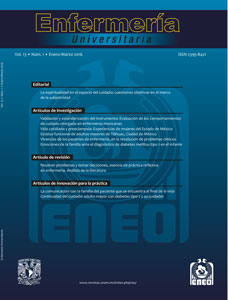Daily life and pre-eclampsia: Experiences of women at the State of Mexico
Main Article Content
Abstract
Objective: To analyze the experience of living with pre-eclampsia among women at the State of Mexico who are attended at the General Hospital of Chimalhuacan.
Method: This is a qualitative research with a phenomenological and hermeneutic approach with the theoretical focus of Alfred Schütz. The sample was defined using the criteria of theoretical saturation. Data were collected through a semi-structured interview and analyzed using the Van Manen method. Six scientific rigor criteria were used: credibility, transferability, consistency, confirmability, relevance, and theoretical and epistemological adequacy.
Results: Five categories emerged: 1) meaning of pre-eclampsy in daily life, 2) physical and emotional experience of living with pre-eclampsy, 3) interpretation of self-care in the daily life of women with pre-eclampsy, 4) supporting networks which help women survive the experience of having pre-eclampsy, and 5) meaning of the Health Services.
Conclusions: Pre-eclampsy, a multi-factorial pregnancy illness with a high impact on Health Services, is one of the main causes of maternal deaths in Mexico. Because of their living in constant crisis, women with pre-eclampsy have higher vulnerability and risk of death, and their lives are affected both physically and emotionally. Here, it was ratified that supporting networks are critical to address this problem and strengthen these women’s capacity to achieve a balance in their environment and daily life.
Publication Facts
Reviewer profiles N/A
Author statements
- Academic society
- N/A
- Publisher
- Universidad Nacional Autónoma de México
Article Details
Dimensions citation
MÉTRICAS
Enfermería Universitaria by Universidad Nacional Autónoma de México it is distributed under the License Creative Commons Attribution - NonCommercial - NoDerivatives 4.0 International
Accepted and published articles become open-access under the terms of the Creative Commons CC BY-NC-ND 4.0 license, which authorizes the reproduction and sharing without commercial purposes, provided the corresponding acknowledgments to their authors. Authors are allowed to manage a self-archive copy of the article’s published version so that they can open-access it in their personal or institutional web pages, and/or any other broad-diffusion space.


